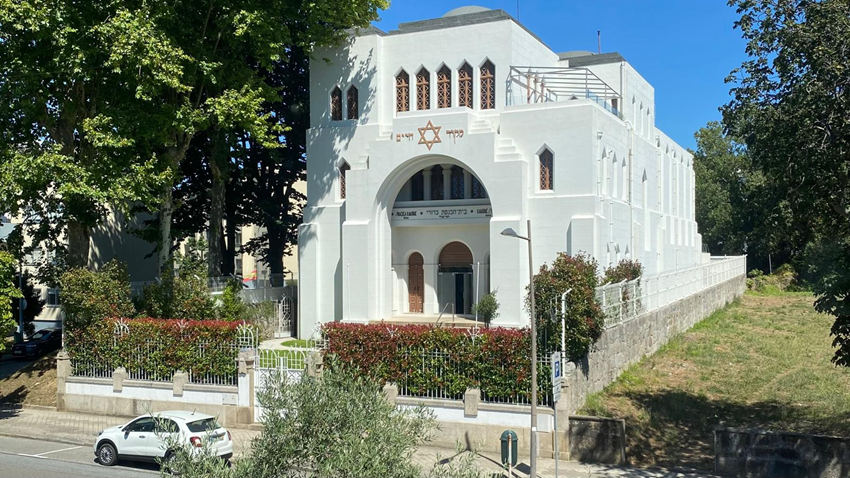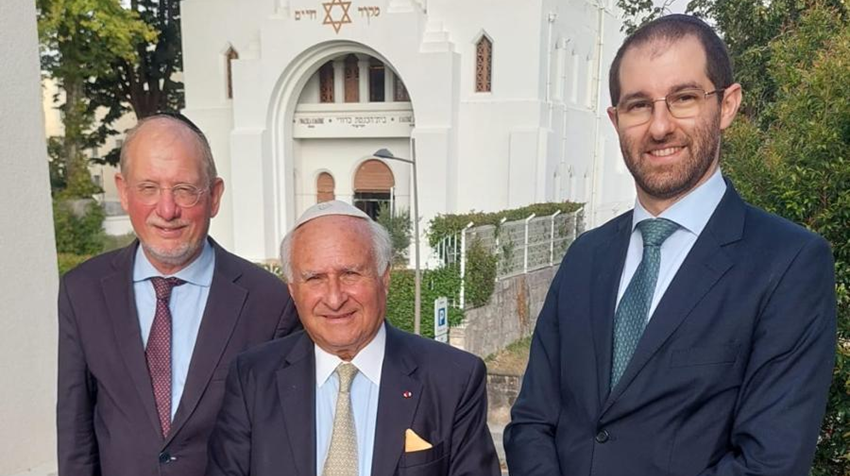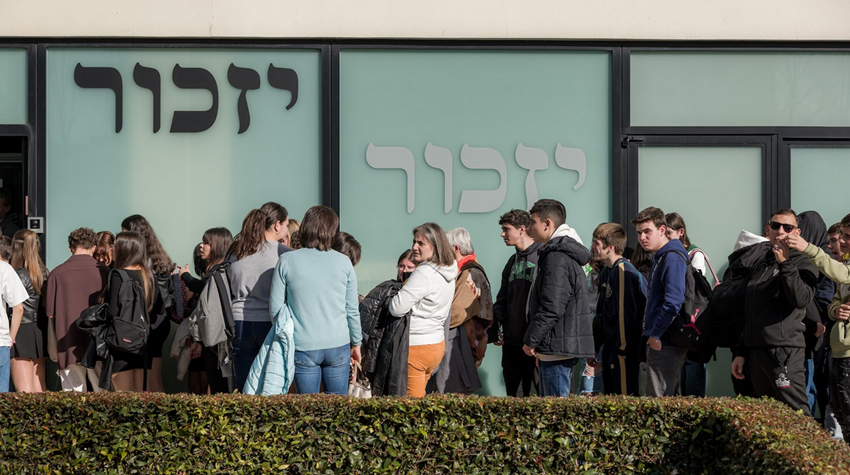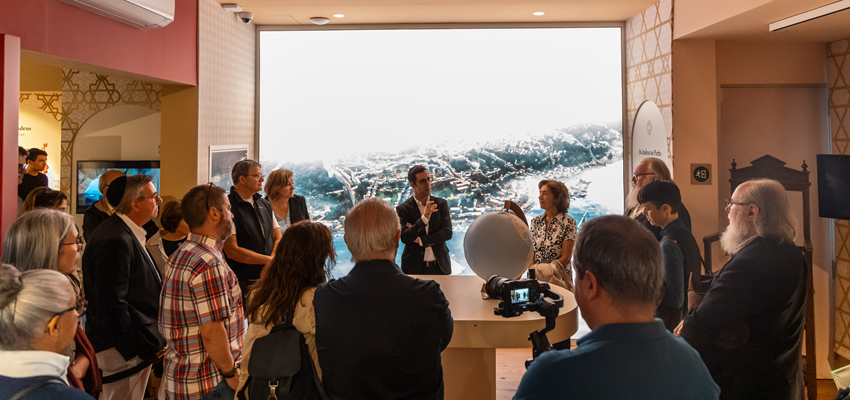The Kadoorie Mekor Haim Synagogue. Credit: Jewish Community of Oporto
When he helped build the 2,000 m2 synagogue in Oporto in the 1930s, Sir Lawrence Kadoorie of Hong Kong revealed to Captain Barros Basto that he had reason to believe that such a majestic monument might not have been necessary at the time, given the small size of the community then existing in Portugal, and especially in Oporto. However, he was certain it would be very useful in the future. It is well known that the community practically died out for decades after the persecution of the "Portuguese Dreyfus" (1934-1937), but it has regenerated tremendously in the 21st century. The community today is extensive and continues to have the Kadoorie Mekor Haim synagogue as its greatest reference. Were it not for the synagogue, which brought together the city's few Jews in decades past, the community might not exist. It does exist. And what has happened in the last decade and a half clearly demonstrates this, not only due to the large number of Jews in the community, but also due to their faith and capacity for work.
How it all began: the rehabilitation of a ghost building
In early 2012, the state of the Kadoorie Mekor Haim synagogue building could not have been more dramatic. The monument looked little different from a ghost house to any impartial passerby on Guerra Junqueiro Street. The paint that once made the city's beautiful Jewish temple shine had given way to moss and cracks that stretched from top to bottom. The walls surrounding the grounds were no more than a metre high, and any ill-intentioned criminal could easily invade the premises to take drugs or endanger members of the community or its property. Behind the building stood a stinking dump and an old, disused chicken coop. The garden Captain Barros Basto had lovingly created many decades earlier was now nothing more than a disjointed cluster of shrubs and plant pots, amidst which stood two enormous palm trees, dead from fungus and red palm weevils that had destroyed their roots and internal tissues—in short, large trees that had to be removed immediately, lest they collapse onto the street and cause a tragic accident.
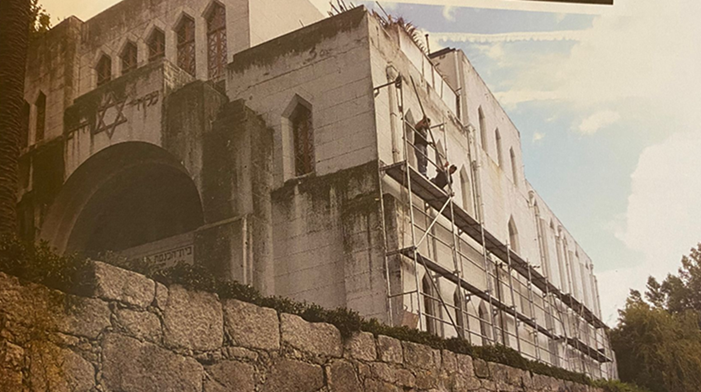
The Kadoorie Mekor Haim Synagogue building at the beginning of the rehabilitation process. Credit: Jewish Community of Oporto
Inside the building, the situation wasn’t any more welcoming. Dampness permeated every room and came from the most unexpected places. It rained inside the temple due to the leaking ceiling. Sometimes religious services, with no more than a handful of astonished visitors, had to be held in the stairwells, as the ancient electrical system constantly short-circuited, resulting in blackouts at the most inopportune moments. Only by a miracle did the building not catch fire, according to the electricians who went there at the time to check what could be done. The basement was unusable, housing a family of caretakers who lived in that windowless space, as if buried in a coffin. Rats in good physical condition swarmed from the auxiliary rooms, and the mikveh, a key factor in Jewish life, was nothing more than a dark, rust-filled tank filled with ice water.
The rooms of the Rosh Pinah library and the old Yeshiva could not have smelled more strongly of mould, a type of fungus that thrives in damp, poorly ventilated environments. The upper floor was occupied by an old, rotting kitchen, windows with broken panes, and quarters for a supposed religious leader whom, due to financial constraints, the community had never hired since the synagogue's inauguration in the 1930s. When more than ten people gathered in the room, everyone feared it would collapse and a fatal disaster would ensue, as the rotting, creaking floorboards would bend a hand's breadth.
The only temple in northern Portugal belonging to a people so renowned for cleanliness, culture, hard work, and prosperity, the building was, as a whole, a puzzle for any Jewish tourist travelling there from elsewhere, and it wasn't even registered with the land registry.
All of this needed to be corrected. And it was—an effort that began in the second half of 2012 and continued into the following years, with record-breaking completion times constantly being achieved. A vast renovation project on the building's exterior took place, including its complete painting and registration with the land registry, and all of this was accomplished in parallel with the felling of the garden's dead palm trees and disorganized shrubs, in exchange for two young olive trees, a beautiful lawn, and an irrigation system. Walls and fences were erected to prevent strangers accessing the property, the main gate was reinforced and fitted with bulletproof glass, the facades were cleaned, painted, and lit, the entire floor was replaced, stormwater drainage lines were built, the rotting sewage system was repaired, and the old dump at the back of the property gave way to a new building, built in two months, to serve as a restaurant, industrial kitchen, and large sukkah.
Regarding the interior, the work was even more intense. The main prayer room had its seating capacity more than doubled, the lighting capacity was also doubled after the entire electrical system was replaced. The ceilings, floors, and walls were restored, and the side doors were reinforced with plating. The floor was replaced with wooden flooring, and a grocery store and a space that replaced a vending machine were created. In the basement, a second prayer room was built with central heating and double-glazed windows with thermal insulation, two backlit screens with images of the Kotel (Wailing Wall) were installed, a floating floor was installed, and spaces were created for an archive room, office, storage, and security bunkers. The mikveh's comprehensive renovation transformed a dark, smelly hole into a space reminiscent of a luxurious hotel spa.
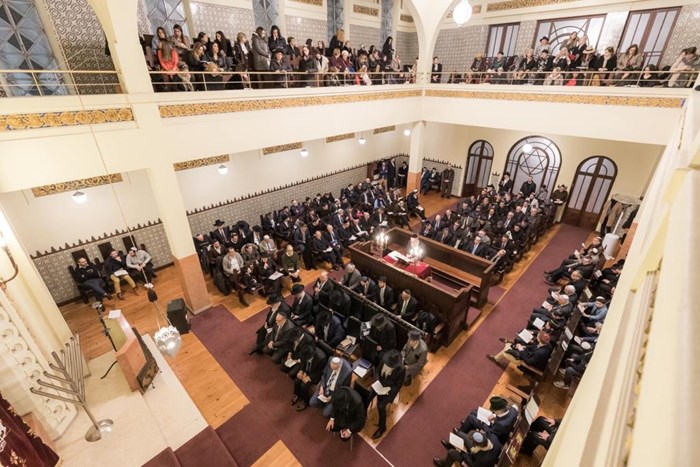
The Kadoorie Mekor Haim Synagogue. Credit: Jewish Community of Oporto
On the first floor, the three library rooms were renovated, thermally adequate windows were installed, toilets were built, and the existing humidity was replaced with light and heat, thanks to the installation of a powerful electrical system. On the second floor, the entire building was shored up, the floor was reinforced with transverse and longitudinal steel beams, the flooring was replaced, the kitchen was rebuilt, a pantry and other private spaces were created, the existing residential rooms were demolished, and the dining room was significantly expanded by demolishing and reinforcing the master walls with steel beams.
A decade of minyan completed
It was the "Portuguese Dreyfus" case, which occurred in 1937, that brought eight decades of shekhinah begalutah (absence of divine presence) to the community. It was doubly negative. Not only did God remain distant from community life and uninvolved, but the community also continually failed in all its initiatives to create Jewish life. The experience was brutal. The weight of the shekhinah begalutah proved unbearable and allowed nothing to be built, like wet firewood that won't burn no matter how hard you try. The energy in the synagogue was one of paralysis, of darkness, of a black hole that swallowed everything in a seemingly endless scene of death.
After holding major religious events in 2013 and 2014, albeit scattered, the following year began the work of maintaining a constant minyan, without gaps or interruptions. Today, in 2025, it can be said that a historic milestone has been reached. Nothing similar has happened in Portugal since 1497, when Judaism was banned. Ten consecutive years of minyan on Shabbat and Yom Tov in the central synagogue, without a single interruption, is a source of great joy, especially since the community has a second synagogue, for young students, which has held a daily minyan for four years. Each year represents a complete cycle of Torah readings, with the call of congregants to the bimah. In Tishrei, the year's readings (the tenth) were completed, and the book of Genesis was restarted.
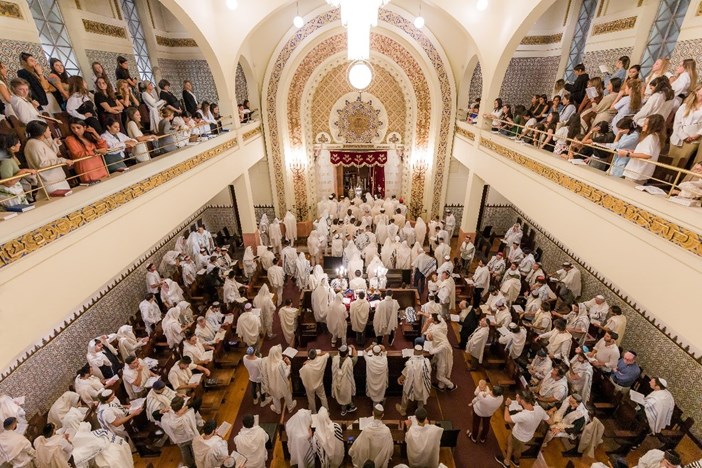
Celebration of Yom Kippur at the Kadoorie Mekor Haim Synagogue. Credit: Jewish Community of Oporto
The benefit of always praying with a minyan is not limited to the possibility of saying kaddish and kriah. A minyan brings the shekhinah (divine presence), and each Amen uttered has effects in the mystical and material world. The true shekhinah assures God's intervention in earthly events, just like the cloud and fire that once guided the Israelites in the wilderness. This active presence is marked by divine involvement in all things, projecting radiance and good fortune.
The minyan, literally "the count," doesn’t mean having 10 men present at the rituals, but at least 10, and it could be dozens or hundreds. It's commonly thought that the minimum number of worshippers required for the ritual to have no limitations is ensured by a large community. This isn't the case. Ten years corresponds to thousands of religious services spread throughout different times of the year, in heat, cold, and rain. As a general rule in the diaspora, most people don't have the habit of attending synagogue regularly; others travel extensively, there are vacations, illness, inability to travel, insecurity and fear of terrorism, and other reasons that always hinder the functioning of synagogues far from the homes of most of their members.
Although positive community constellations were already apparent with the complete renovation of the synagogue, the first major shabbatonim, and the opening of a kosher hotel—events that occurred between 2012 and 2014, as mentioned above—the truth is that the greatest developments (two fully functioning synagogues, kosher establishments, a tzedakah network, a cemetery, and so on) only emerged from the moment the permanent minyan made its appearance. May it last for many years, despite everything.
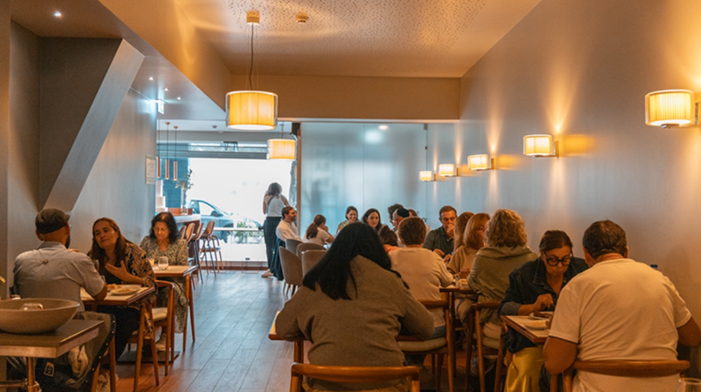
Iberia Kosher Restaurant. Credit: Jewish Community of Oporto
Kashrut, from zero to a hotel, restaurants and grocery stores
The community had nothing in the way of kashrut in 2012. There was a lack of properly certified essential products, there were no places to prepare meals, there were no kosher restaurants, and visitors to the synagogue couldn't find basic necessities there, or anywhere else. This isn't a problem today. Let's look at what was achieved year by year:
2012 – Complete renovation of the synagogue’s community kitchen.
2013 – Organization of two Shabbatonim with a large number of visitors, with meals prepared with products from Golders Green in London
2014 – Opening of a kosher restaurant and kosher shop at the Hotel da Música, 1 km from the central synagogue.
2015 – Acquisition of furniture to seat 420 people for meals in the synagogue, especially during the annual Shabbatonim, attended by some of the most prominent rabbis in the world.
2016 – Opening of a grocery store in the synagogue, construction of a kiddush room for 200 people, and inauguration of a store with vending machines for drinks, coffee and hot food.
2017 – Opening of a community restaurant, with an industrial kitchen, behind the synagogue.
2018 – Opening of two community-sponsored restaurants owned by the Israeli families Dadon and Dahan.
2019 – Opening of a Study Centre for young French people, operating in a rented café that has been koshered to prepare and serve meals.
2020 – Opening of the Ibéria restaurant, next to the Holocaust Museum, which remains the central restaurant for Oporto's Jews to this day.
2021 – Inauguration of the kosher Port wine cellar at the Jewish Museum. The space houses a thousand bottles.
2022 – Inauguration of a second synagogue with a dining area and a fully equipped kitchen. Young French people, with community support, also opened a restaurant and a kosher shop next to the university for young French Jews.
2023 – Presence in Oporto, with community kashrut for three days, of leaders of Jewish communities from Portugal to Ukraine, in an event chaired by the European Jewish Association.
2024 – The Rabbinical Centre of Europe, in partnership with the Jewish community of Oporto, held a three-day event in the city specifically on kashrut, with participants from all over the world.
2025 – Opening of a new kosher grocery store by the community, next to the Ibéria restaurant.
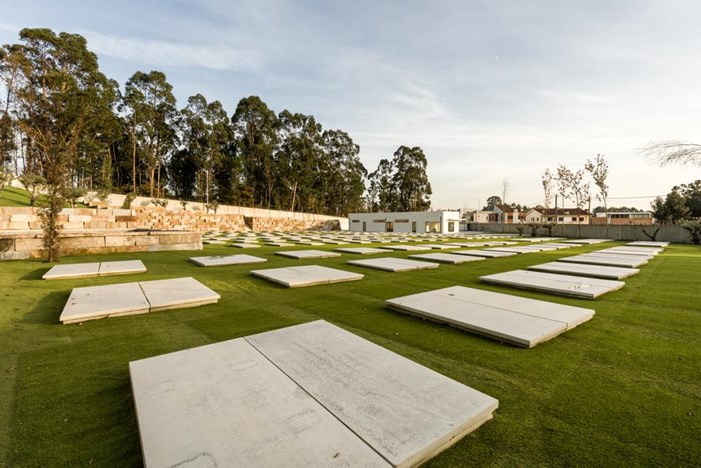
The Jewish Cemetery of Oporto. Credit: Jewish Community of Oporto
Cemetery opened five centuries later
There had been no cemetery in the city for five centuries. After King Manuel's edict at the end of the 15th century, the Jews of Oporto were robbed of all their possessions and homes, and even the cemetery was dismantled. It had always been Barros Basto's aspiration to build a cemetery for Oporto's Jewish community. He was unable to do so because the system wouldn't allow it. His successors, who in recent years contributed to the rehabilitation of Jewish religious life in Oporto, whether by rehabilitating and developing the infrastructure or by creating conditions for Judaism to flourish, did nothing more than fulfil a duty to the Jewish people and the history of Jews in Portugal. And they did. This must be recorded, not silenced, much less falsified.
The new community’s cemetery is located in a discreet location on the outskirts of Oporto. Nearby, there are no tall buildings, streets, traffic lights, cars, or people talking loudly. Peace reigns supreme. It is a beautiful space, with grass, trees, a lake, and the chirping of cheerful birds. Besides this, there is only silence. The land was acquired by the community in 2016. The cemetery was inaugurated in 2023, after seven years of bureaucratic complications regarding its construction. The cemetery's name: "Isaac Aboab," the last Gaon of Castile. He lived and died in Oporto after the expulsion of the Jews from Spain.































